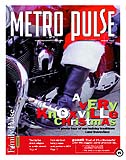 |
 |

photographs by Valerie Downes, Aaron Jay,
and K. Snowden
In spite of the dozens of smells we associate with the season, and the 100
or more Yuletide carols we all recognize because we hear them everywhere,
Christmas is still a holiday that's mostly about light and image, a frontal
assault on the darkness of late Decembers. In ancient times, when the noon
sun sank lower in the sky as each night grew longer than the one before it,
people panicked. They feared that this time, if they'd fallen out of favor,
the sun would go away forever. So they tried to lure it back with extravagant
lights and brightly colored decorations. (Did it ever really have all that
much to do with celebrating the life of the ascetic prophet who said, "Ye
cannot serve God and Mammon"?)
Of course, we've understood the mechanics of the winter solstice for centuries.
By the time Americans overcame their puritan objections to Christmas and
began to celebrate it, the motion of the planets was grade school stuff.
We knew that by every December 25th, the earth would have begun to right
itself, and soon we'd have the sun back. Still, if we no longer fear abandonment
by the sun, if we no longer suffer heathen panic about the shortness of the
days, we do acknowledge something called seasonal affective disorder
which strikes at the solstice and can be treated with bright lights.
So here in the late 20th century, we still burn bright lights in the darkness,
keep our stores open as late as summer days used to be, deck our cities in
brightly colored decorations, and rush around like panicking druids, as if
all these centuries later we're still raging against the dying of the light.
And here at the bottom of this thickly wooded river valley, the shadows fall
even earlier. You won't find many darker cities than Knoxville in December.
Maybe that's why Knoxvillians feel such an obligation to illuminate the season
and cheer the lives of strangers.
So Merry Christmas. Here are some bright images that caught our attention
this year. |